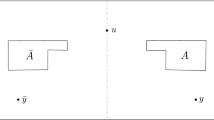Abstract:
Monte-Carlo results for the moments of the magnetization distribution of the nearest-neighbor Ising ferromagnet in a Ld geometry, where L () is the linear dimension of a hypercubic lattice with periodic boundary conditions in d=5 dimensions, are analyzed in the critical region and compared to a recent theory of Chen and Dohm (CD) [X.S. Chen and V. Dohm, Int. J. Mod. Phys. C 9, 1007 (1998)]. We show that this finite-size scaling theory (formulated in terms of two scaling variables) can account for the longstanding discrepancies between Monte-Carlo results and the so-called “lowest-mode” theory, which uses a single scaling variable tL d/2 where is the temperature distance from the critical temperature, only to a very limited extent. While the CD theory gives a somewhat improved description of corrections to the “lowest-mode” results (to which the CD theory can easily be reduced in the limit , , tL d/2 fixed) for the fourth-order cumulant, discrepancies are found for the susceptibility (). Reasons for these problems are briefly discussed.
Similar content being viewed by others
Author information
Authors and Affiliations
Additional information
Received 4 September 1998
Rights and permissions
About this article
Cite this article
Luijten, E., Binder, K. & Blöte, H. Finite-size scaling above the upper critical dimension revisited: the case of the five-dimensional Ising model. Eur. Phys. J. B 9, 289–297 (1999). https://doi.org/10.1007/s100510050768
Issue Date:
DOI: https://doi.org/10.1007/s100510050768



